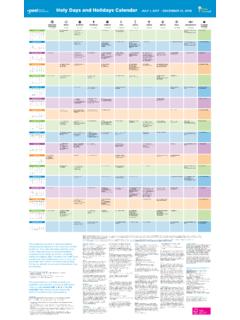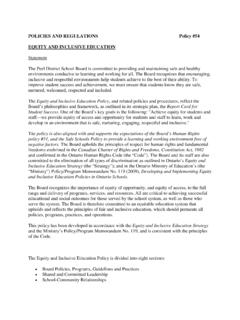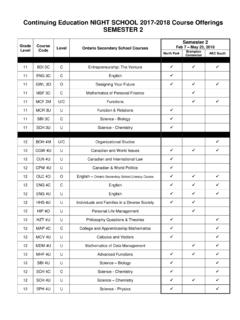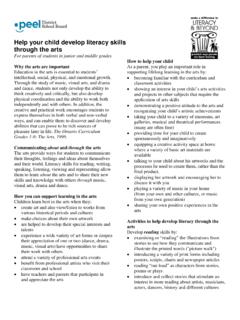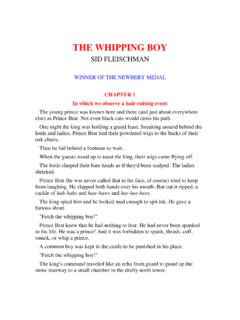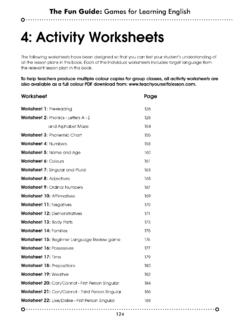Transcription of Character Attributes in Action - Peel District School Board
1 Character Attributes in ActionVALU ES TAUGHT DAILY A RESOURCE FOR KINDERGARTEN TO GRADE 9An educator s guide to promoting student wellness with physical activity, focused on Character developmentAt the Peel District School Board , we value the development of the whole child, which is why we commit to the teaching and learning of our six core Character Attributes : CARING COOPERATIVE HONEST INCLUSIVE RESPECTFUL RESPONSIBLEThe Character development of the people who work and learn inside our buildings matters. A key phrase we ask our Peel Board community is:What will you learn INSIDE these doors that will help you be your best OUTSIDE these doors?An effective way to teach the Character Attributes and learn about them is to have fun while being physically active. While developing Character Attributes in an active way, students will also develop better social skills, improve their learning skills, and have better physical and mental wellness all while meeting curriculum objectives.
2 Being active in a purposeful and playful way gives us energy, reduces stress and anxiety, and increases our feelings of well-being. This document has been developed by teachers for teachers. This resource provides 10 fun physical activities for each of the 6 Character Attributes to be used during Physical Education classes, outdoor activities, Daily Physical Activity (DPA), team building events or for a physical release in the classroom. We hope you will have as much fun using this document as we had in creating it! Character Attributes in ActionEQUITYINCLUSIONRESPECTSafe, Nurturing, Engaging, Relationships & EnvironmentsCharacter Attributes in ActionConflict/ Bullying/ Violence Prevention & InterventionRestorative PracticesSafe, Nurturing & EngagingRepairHealthy RelationshipsWorking with Challenging Emotions/BehavioursCharacter Attributes in ActionClimate for Learning and Working2 Peel District School Board Values Taught Daily Lesson PlansEach lesson plan includes: Character attribute : The Character attribute that will be the focus of the lesson and follow-up conversations are Goal: Specific learning outcomes for the activity are Skills: Connections to the Health and Physical Education Curriculum are : Materials needed for the activity are : All pre-work that is required to prepare for the activity is explained.
3 Instructions: Step-by-step instructions for completing the activity are for Consolidation: Post-questions are suggested in order to assess student learning and to engage students in dialogue about the identified Character attribute . How students can demonstrate this Character attribute outside of class can also be discussed at this time. Photo and Video: A photograph and a YouTube link of the activity in Action are provided in order to deepen the understanding of the activity for the document would not have been possible without the dedication, creativity and persistence of these dedicated teacher professionals:Jennifer CuthbertsonSteven KilleenAlisa McClureAviva RosenbergLisa TuttyThanks to the Peel District School Board Climate for Learning and Working Team who helped compile this resource:Kelly KrugCLIMATE FOR LEARNING AND WORKING COORDINATOR Sayema Chowdhury CLIMATE FOR LEARNING AND WORKING RESOURCE TEACHERRubi Pourawal CLIMATE FOR LEARNING AND WORKING RESOURCE TEACHER3 Peel District School Board Values Taught Daily Grouping Strategies to Ensure InclusionMany activities in this document require students to work in groups.
4 Well-designed groups support positive student interactions and have the power to help students become part of an environment in which they feel respected, included and connected to one another. As these are the environments where students flourish and maximum learning occurs, it is essential that educators be thoughtful in their grouping practices and give careful and intentional attention to how students will be grouped for these activities. Purposeful organization of student groupings ensures that vulnerable students are not marginalized or excluded. When students are asked to form their own groups, this encourages students who are alike to come together and those who are viewed as different to be excluded. When teachers intentionally group students, this can prevent embarrassment of not being chosen for a group and thus being forced into a pre-established group. For the purpose of the activities in this document, classes can be divided into groups using random grouping methods (rather than intentional grouping strategies).
5 The following are a list of fun and quick ways to group students. Each of these methods encourages students to work with new people often, gives students an opportunity to still work with their friends, and helps promote an environment of inclusion. 4 Peel District School Board Values Taught Daily There are many benefits of teachers taking the responsibility for creating student groups. When students work with peers who they normally would not work with in an environment where the demonstration of the Character Attributes are expected, it has the power to enhance peer dynamics, promote optimal peer inter-actions, develop students social skills, increase empathy, build relationships across the classroom, and increase feelings of safety, inclusion, respect and belonging. In these kinds of environments, students are motivated and engaged; they are excited to learn from one another and feel supported by their peers. Ensuring inclusion through the use of grouping strategies has the power to transform a class into a community!
6 ACTIVITYINSTRUCTIONSS ocksUsing a bag of clean socks, have students pick one then find its pair. For larger groups, pairs join other pairs by size or colour to form larger sub-groups. Ask a QuestionAsk a question to the class. Those who say yes move to one end of the room, those who say no , move to the other. For example, ask the class, When you put your socks on, do you put the right one on first? Instead of yes or no questions, you could ask questions giving the number of options that you need groups. For example, What flavour ice cream do you like better; chocolate, strawberry or vanilla? Chocolate moves to one side, strawberry to another, and vanilla to CardsPass out playing cards and group students based on having similar or different suits, black or red cards, cards in a specific order, the same numbers, or any other values you assign to the and EvensAsk students to count up the letters in their first name and determine if they have an odd number of letters or an even number of letters.
7 Odds could move to one end of the playing space and evens could move to the other. If you need bigger groups, you can ask students to find three or four others who also have an even or odd number of letters in their name and form a group. Birthday BuddiesAsk students to group together based on who has the same birthday month as them. You could also ask students to group together based on the season they were BuddiesHave students choose the fast food establishment they like the best. Have choices for the number of groups that you would like. Example, Which do you prefer? McDonald s, Burger King, Subway, etc. Colour PencilsHave students pick coloured pencils out of a can. Have four or five of the same color and have as many colors as you need PairsMake index cards ahead of time. On each pair of cards, write a famous pair that serves as a way for students to form pairs. For example, write peanut butter on one card and jelly on the other.
8 Other ideas: spaghetti and meatballs or Romeo and Juliet or October and Halloween or Tom and Jerry . Pick a Word, Any Word Write a word on an index card and then on the next two, three or four cards, write synonyms for the original word. For example, you could have cards containing the words large, gigantic, huge, enormous, and so forth. Do the same with additional sets of cards using different sets of synonyms for however many number of groups you want. Ask each student to pick a word, any word. Once everyone has a card, explain to them that they will be working in synonym groups, and if necessary, remind them what synonyms are. Students then form themselves into groups based on matching synonyms. This approach could also be used for homonyms, antonyms, figures of speech, or pretty much anything else that can be Shake AppUse the Team Shake app to randomly select names to create PuzzlesCut pictures from a magazine so that there are half as many pictures as members of the group.
9 If you have a theme, try to find pictures related to the theme. Cut each picture in half, thirds or quarters (dependent on the number you want in each group) and mix them up in a bin. Each student takes one piece and groups are those whose pieces form a complete District School Board Values Taught Daily 6 Peel District School Board Values Taught Daily 7 CARING 9 Up, Over and Down 10 Fill Your Bucket 11 Help! Help! Help! 12 Reducing Litter 13 Plant a Tree with TLC 14 Be My Valentine 15 Squished Ants Tag 16 Parachute Care 17 Chuck the Chicken 18 alphabet Tag and Super Hero Tag 19 COOPERATIVE 21 Human Knot 22 Building the CN Tower 23 Traffic Jam 24 Mystery Maze 25 Caterpillar on Course 26 Magic Carpet Walk 27 Back to Back 28 Tent 29 Mushroom 30 Cloud 31 HONEST 33 Chicken Relay Race 34 Whistle Locomotion Freeze 35 Rock-Paper-Scissors Ha Ha Ohhh 36 Pokemon Math Dodgeball 37 Pokemon Tag 38 Hockey Stick Handling Continuous Relay 39 Hot Dog Tag 40 Auto Wreckers 41 Everybody It Tag and Survivor Series 42 Cat and Mouse 43 INCLUSIVE 45 Get Together 46 Save Your Planet 47 Martian From Mars 48 Stuck in the Middle 49 Stinky Cheese Touch 50 Discriminating Doctor Dodgeball 51 Rock-Paper-Scissors Cheer 52 Everybody In!
10 53 Switch! 54 Stop Picking on Me! 55 RESPECTFUL 57 Olympic Rock-Paper-Scissors 58 R-E-S-P-E-C-T Relay 59 Toilet Tag 60 Oh Deer! 61 Circle of Respect 62 Trash Balls 63 Partner Move 64 Object Move 65 Back Me Up Tag 66 Helping Hands 67 RESPONSIBLE 69 Yoga 70 Warm Up Leader 71 Tag, You re It 72 Sinking Ship 73 Rock-Paper-Scissors: Beat the Leader 74 Let s Get to 100 75 Equipment Manager Relay 76 Circuit Time 77 Responsibility Gallery Walk 78 alphabet TagTable of Contents 2 Character Attributes in Action 3 Lesson Plans 3 Acknowledgements 4 Grouping Strategies to Ensure Inclusion7 Peel District School Board Values Taught Daily You show CARE when you: Show kindness towards people and other living things. Listen to and respond appropriately to the concerns of others. Help others who are in need. Demonstrate empathy by recognizing and identifying with the feelings of others. Protect and respect the Showing compassion and kindness toward others Never believe that a few caring people can t change the world.
